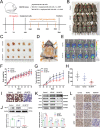Adipocyte-Derived Exosomal MTTP Suppresses Ferroptosis and Promotes Chemoresistance in Colorectal Cancer
- PMID: 35978266
- PMCID: PMC9534973
- DOI: 10.1002/advs.202203357
Adipocyte-Derived Exosomal MTTP Suppresses Ferroptosis and Promotes Chemoresistance in Colorectal Cancer
Abstract
Obesity is closely related to a poor prognosis in patients with advanced colorectal cancer (CRC), but the mechanisms remain unclear. Ferroptosis is a form of nonapoptotic cell death characterized by lipid reactive oxygen species (ROS) accumulation and iron dependency and is associated with the chemoresistance of tumors. Here, it is shown that adipose-derived exosomes reduce ferroptosis susceptibility in CRC, thus promoting chemoresistance to oxaliplatin. It is found that microsomal triglyceride transfer protein (MTTP) expression is increased in the plasma exosomes of CRC patients with a high body fat ratio, serving as an inhibitor of ferroptosis and reducing sensitivity to chemotherapy. Mechanistically, the MTTP/proline-rich acidic protein 1 (PRAP1) complex inhibited zinc finger E-box binding homeobox 1 expression and upregulated glutathione peroxidase 4 and xCT, leading to a decreased polyunsaturated fatty acids ratio and lipid ROS levels. Moreover, experiments are carried out in organoids, and a tumor implantation model is established in obese mice, demonstrating that the inhibition of MTTP increases the sensitivity to chemotherapy. The results reveal a novel intracellular signaling pathway mediated by adipose-derived exosomes and suggest that treatments targeting secreted MTTP might reverse oxaliplatin resistance in CRC.
Keywords: MTTP; adipose tissue; chemoresistance; colorectal cancer; exosomes; ferroptosis; organoids.
© 2022 The Authors. Advanced Science published by Wiley-VCH GmbH.
Conflict of interest statement
The authors declare no conflict of interest.
Figures











References
-
- Miller K. D., Nogueira L., Mariotto A. B., Rowland J. H., Yabroff K. R., Alfano C. M., Jemal A., Kramer J. L., Siegel R. L., Cancer treatment and survivorship statistics 2019 , CA: Cancer J. Clin. 2019, 69, 363. - PubMed
-
- Sung H., Ferlay J., Siegel R. L., Laversanne M., Soerjomataram I., Jemal A., Bray F., CA: Cancer J. Clin. 2021, 71, 209. - PubMed
-
- André T., Boni C., Navarro M., Tabernero J., Hickish T., Topham C., Bonetti A., Clingan P., Bridgewater J., Rivera F., De Gramont A., J. Clin. Oncol. 2009, 27, 3109. - PubMed
-
- Kuebler J. P, Wieand H. S, O'connell M. J., Smith R. E., Colangelo L. H., Yothers G., Petrelli N. J., Findlay M. P., Seay T. E., Atkins J. N., Zapas J. L., Goodwin J. W, Fehrenbacher L., Ramanathan R. K., Conley B. A., Flynn P. J., Soori G., Colman L. K., Levine E. A., Lanier K. S., Wolmark N., J. Clin. Oncol. 2007, 25, 2198. - PubMed
Publication types
MeSH terms
Substances
Grants and funding
- 82072664/National Natural Science Foundation of China
- 81974374/National Natural Science Foundation of China
- 82173125/National Natural Science Foundation of China
- 81802363/National Natural Science Foundation of China
- 81702431/National Natural Science Foundation of China
- 18JCQNJC81900/Tianjin Science Foundation
- 18JCYBJC92000/Tianjin Science Foundation
- 18JCYBJC25400/Tianjin Science Foundation
- 18JCYBJC92900/Tianjin Science Foundation
- 2018KJ046/Science & Technology Development Fund of the Tianjin Education Commission for Higher Education
- 2017KJ227/Science & Technology Development Fund of the Tianjin Education Commission for Higher Education
LinkOut - more resources
Full Text Sources
Medical
Research Materials
Miscellaneous
